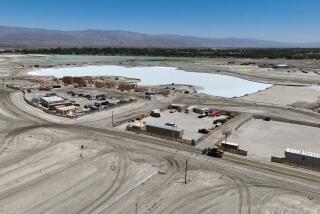Rich Enclave Values Privacy
- Share via
RANCHO SANTA FE, Calif. — Here amid the eucalyptus trees, horse trails and multimillion-dollar mansions, where life is unhurried and gracious, residents have a new distinction: They live in the wealthiest community in the United States.
With a burst of per capita income to $113,132, Rancho Santa Fe has nosed out Atherton and Woodside in the San Francisco Bay Area, Palm Beach, Fla., Bloomfield Hills, Mich., and other high-living rivals, according to U.S. census data released Tuesday.
The 5,000-plus residents of “the ranch,” 25 miles north of San Diego, are taking their newfound status with their usual understated aplomb.
“Life is cool here, dude,” joked Arthur Laffer, author of the Reagan administration economic theory called the Laffer Curve.
This is a community where life revolves around the members-only golf course and the Garden Club, a place where sidewalks and street lights are forbidden, and where an ironclad homeowners’ agreement called “the Covenant” allows the Art Jury to decide even the smallest detail of landscaping and architecture.
“It’s Beverly Hills in the country,” said CBS sportscaster Dick Enberg, who lived here for 17 years before moving two years ago to La Jolla, to be closer to the private school his three teenagers attend. “It’s just idyllic.”
The success of Rancho Santa Fe as a community for the rich began with its failure as a tree farm for the Santa Fe Railway. Before World War I, the railroad planted thousands of eucalyptus trees on what had largely been barren, rolling hills.
But towering eucalyptus timber proved unsuitable for railroad ties. That plan went bust. Today, long, winding driveways lead to Spanish, Mediterranean and ranch-style homes (median value: $1.7 million) on minimum two-acre lots. Horse corrals and garages packed with vintage cars are common.
“People here have spent a lot of money for their homes, and they expect their lifestyle to be protected,” said Walt Ekard, former manager of the Rancho Santa Fe Assn. “They’re hard people to argue with: Even when they’re wrong, they sound right. These are people who are used to being in charge.”
A who’s-who of Fortune 500 executives, retired diplomats and celebrities has called “the ranch” home: McDonald’s heiress Joan Kroc, ex-Universal Studios boss Sy Salkowitz, astronaut Wally Schirra, actors Victor Mature and Robert Young, Taco Bell founder Glenn Bell, Padre owner John Moores and Trevor Hoffman, a star relief pitcher with the baseball team.
More notorious residents included the Heaven’s Gate cult members, before their 1997 mass suicide, $100-million swindlers J. David Dominelli and Nancy Hoover, before they went to prison, and a mysterious Briton named Ian Spiro and his family before they were murdered. (Conspiracy theories abound, but the official finding was that Spiro, beset by financial and emotional problems, killed his loved ones and committed suicide.)
Like Howard Hughes before him, Bill Gates owns a home here, but sightings are rare. Even if ranch residents have seen the Microsoft baron, they probably would not say. Privacy and discretion are local virtues.
For such a rich community, discussion of money--particularly around outsiders--is considered boorish.
“Darn, we have great weather here,” said John Marelli, who gave his profession as farmer when asked Tuesday about the community’s wealth. He was taking putting practice at the golf club founded in 1927 by Bing Crosby.
Publicity from the census findings--which apply to communities with more than 1,000 households--is anything but relished here.
“The last thing in this world we want is to be known as the richest town in America,” said Sandy Bien, vice president of the Garden Club. “We’re just a pretty, quaint community full of everyday people.”
Retired executive Bill Cavanaugh concurred: “It’s a mixed blessing. I’d prefer to remain anonymous.”
To enforce its coveted anonymity, the community forbids mailboxes. The local post office is the unofficial gathering spot. “If not for the post office, you’d never see your neighbor,” said real estate agent Patrick Galvin.
To thwart looky-loos after the suicide of 39 Heaven’s Gate believers five years ago, the Rancho Santa Fe Assn.--which functions as a kind of city council--responded by changing the name of the street where the cult had lived in a rented mansion.
When former President Clinton arrived here for a fund-raiser, the mostly Republican residents complained that the Secret Service motorcade scared the horses.
Prying media and noisy politicians are not this community’s only concern.
Its main street is choked each morning and evening with commuters passing through from the coast to the inland portions of the county and vice-versa.
One Rancho Santa Fe matron some years ago wrote a Spanish-English guide for residents to be able to communicate with their hired help.
Locals are willing to live with those trifles. They show no signs of wanting to throw off their splendid isolation, consistently turning down the idea of becoming a city.
Cityhood is seen as a threat to preserving the good life. The Covenant has done its job in governing land use. Cityhood, residents concluded, might mean opening up Art Jury meetings to the public and lifting the residents-only restrictions on the soccer fields.
“What I tell clients,” said real estate agent Galvin, standing at a $5-million, four-acre home with an ocean view, “is this: If you want paradise in your lifetime, come out to ‘the ranch.’”
*
(BEGIN TEXT OF INFOBOX)
Wealthiest Communities
The 10 wealthiest U.S. communities in 2000, their per capita income and the number of households. The number in parentheses is the community’s ranking in 1990.*
Per Capita Households 1990 Income Ranking 1) Rancho Santa Fe, Calif. $113,132 1,200 (NA)
2) Atherton, Calif. $112,408 2,385 (16)
3) Palm Beach, Fla. $109,219 5,697 (7)
4) Bloomfield Hills, Mich. $104,920 1,523 (2)
5) Belle Meade, Tenn. $104,908 1,058 (13)
6) Woodside, Calif. $104,667 1,905 (11)
7) Indian River Shores, Fla. $102,511 1,759 (1)
8) North Hills, N.Y. $100,093 1,814 (10)
9) Cherry Hills Village, Colo. $99,996 1,980 (14)
10) Portola Valley, Calif. $99,621 1,653 (33)
* Among communities with 1,000 or more households
Source: U.S. Census Bureau; Graphics research by Maloy Moore and Sandra Poindexter
More to Read
Sign up for Essential California
The most important California stories and recommendations in your inbox every morning.
You may occasionally receive promotional content from the Los Angeles Times.










